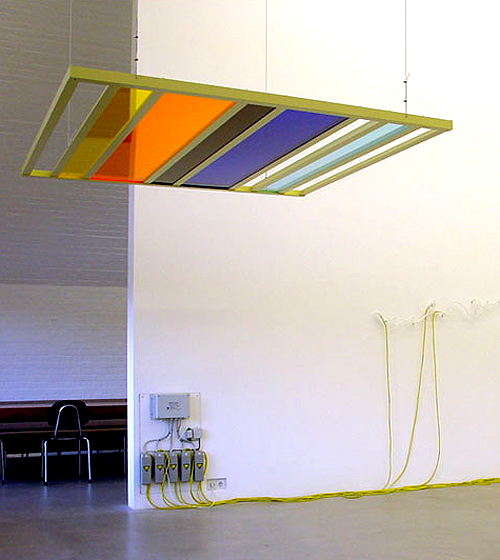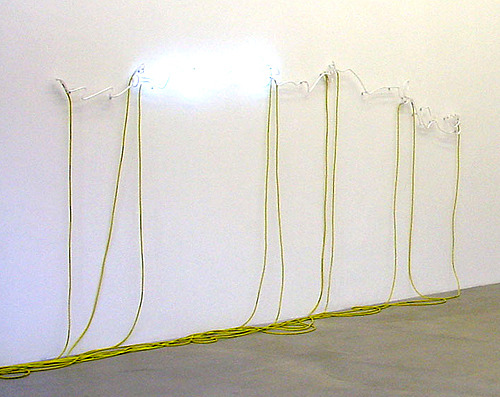

This webpage won't be updated anylonger.
Please visit: www.gerhardsengerner.com


Jonathan Monk, Square Circles Squares, 2002, 16mm
film projection

Sol LeWitt, Irregular Grid, 2001, goache on paper
#009722, 152 x 152 cm

Peter Friedl, Untitled (Berlin), 1998/2003, wall
painting
Peter Geschwind, Sound Cut, 2002, DVD video/audio
Liam Gillick, Doubled Resistance Platform #2, 2001,
powder coated aluminium and transparent plexiglass

Ceal Floyer, ...again and..., 2002, ballpoint pen
on paper, 29.7 x 21 cm

Michel Majerus, Untitled, 2001-2002, 9 paintings,
acrylic on canvas, each 60 x 60 cm

Peter Friedl, Untitled (Berlin), 1998/2003, wall
painting
Peter Geschwind, Sound Cut, 2002, DVD video/audio
Liam Gillick, Doubled Resistance Platform #2, 2001,
powder coated aluminium and transparent plexiglass

Liam Gillick, Doubled Resistance Platform #2, 2001,
powder coated aluminium and transparent plexiglass

 Rirkrit Tiravanija, Untitled, 2003, neon tubes,
electrical cables power supply and control unit, approx 50 x 400 cm
Rirkrit Tiravanija, Untitled, 2003, neon tubes,
electrical cables power supply and control unit, approx 50 x 400 cm
Pressrelease
Perfect Timeless Repetition
Duration: Jan 17–Feb 28, 2003
Opening: Jan 17, 19.00–21.00
We are delighted to present the group show "Perfect Timeless Repetition".
This ambiguous theme features a range of different work by Ceal Floyer, Peter
Friedl, Peter Geschwind, Liam Gillick, Sol LeWitt, Michel Majerus, Jonathan
Monk and Rirkrit Tiravanija. The title of the show is a quotation from Glamorama
(1998) by Bret Easton Ellis.
Ellis' practice of extreme inter-referentiality within his own stories, and
shrewd appropriation of real identities for the characters of the extras in
Glamorama, may be seen parallel to the ideas and art work by Liam Gillick
(b. 1964). Gillick draws upon vast numbers of references in his work as he
experiments with the notions of time, politics and situations that could have
coincided or that may coincide. His writings, videos and filmatic collaborations
(with, among others, Rirkrit Tiravanija) should be regarded as guidelines
to his installations. Gillick presents a platform hanging from the ceiling
occupying a corner in the gallery space where you turn around after you have
passed through the whole exhibition.
In the same way that Bret Easton Ellis scrambles through people and popular
culture, the art of Michel Majerus (b. 1967, d. 2002) reflects our time and
the mass media. His cunning use of puns and slogans and overflowing imagery,
combined with often nihilist or apocalyptic titles, leave us with an ambiguous
feeling about life. We have included a selection of nine paintings by Majerus.
He freely grabbed images and references from popular culture and art history.
In addition to the use of advanced computer programs, he would daringly combine
elements of abstraction with figuration, and thick layers of paint with loose
strokes of sketching. Often incorporating design and computer graphics, he
produced vinyl stickers and silk-screens in order to be able to perfectly
mass-produce series of images in variations. He aggressively questioned the
notion of signature-style and aesthetics, and these smaller works are excellent
examples of his diverse production.
Following the idea of popular culture we find the work by Peter Geschwind
(b. 1966). The
sheer speed of his looped DVD video "Sound Cut", 2002, recalls music
videos on MTV and the audio instantly resembles the music of experimental
electronica musicians such as Squarepusher or Aphex Twin. But this is actually
a more detached and analytical piece, while still very much in the tradition
of experimental music and music video. Geschwind has used a song by the band
Dead Kennedys as an underlying structure for which he has edited a video consisting
of video clips, including sound, of activities like dishwashing and flushing
a toilet.
When removing the original acoustics, he was left with the video clips that
very strictly correspond to the elements of the song, and still keep a sort
of melody. His project can be seen in relation to the music videos by the
French director Michel Gondry for Daft Punk's "Around the World"
(1997) and Chemical Brothers' "Star Guitar" (2001). But Geschwind
does not just add pictures to a piece of music; by setting the parameters
for the editing of the video according to the music [1], he followed the scheme
mechanically in order to combine the clips - only to then remove the soundtrack
and leave us with the sounds from the clips.
"Perfect Timeless Repetition" could indeed have been an instruction
for a conceptual work by the influential artist Sol LeWitt (b. 1928). His
art and writings since the 60's have been crucial to the discussion on art
and art theory, and he still remains one of the most active artists today.
A piece by LeWitt can have an instruction from the artist that should be interpreted
by his assistants who produce the work. He often produces series with all
possible variations of a theme. This way the artist is detached from dealing
with certain aesthetics and details as his involvement is purely cerebral
and conceptual. This attitude to production, and his profound ideas about
art, only opens up to endless possibilities for realization of art. It is
a pleasure to present a large gauche drawing on paper by LeWitt for this exhibition.
The notion of time is a definite understanding of the show's theme and occurs
in several of the pieces by the artists featured in the show. Peter Friedl
(b. 1960) is a politically engaged artist; context and history are evident
parameters in his work "Untitled (Berlin)", 1998/2003. The artist
has simply flipped the number "68" upside down. But the slight disruption
of the typography gives it away and we realize the double meaning of the piece.
In the immediate context of Berlin these numbers obviously refer to the student
revolts in 1968, and the fall of the Berlin Wall in 1989.
Ceal Floyer (b. 1968) presents a thoughtful text piece for the exhibition
where she has written the words "again and" repeatedly on top of
itself with a ballpoint pen until it has been completely blurred and unreadable.
It is as if she tried to mimic her own handwriting. The writing has been carried
out until it destroyed itself and mean nothing anymore. Her ideas always come
through very strong because of the efficient means of execution and her clever
use of references and comments, as well as an often amusing or ironic twist.
By placing her piece in between LeWitt's drawing of repeated lines on top
of each other, and Friedl's contemplation on history, her work underlines
both the process of drawing as well as the notion of time.
Rirkrit Tiravanija (b. 1961) presents a spectacular piece consisting of five
separate neon elements that light up in an endless rapid succession. The piece
is a blow-up from his young nephew's attempt to imitate his handwriting. The
scroll illustrates an illiterate child's difficulty understanding the complexities
of symbols and letters. We might not be able to read his words, but the lines
and the curls are as beautiful as they are awkward. As the successive lights
flash they produce movement along the wall and directly affect the rest of
the environment.
The mechanical operation of a film projector is in itself the ultimate illustration
for the theme of the show. And Jonathan Monk (b. 1969) is the ultimate artist
to make use of a film projector. His 16mm installation consists of squares
of uniquely cut pieces of black paper projected within a thin frame drawn
in pencil. These squares have been cut by hand using a scissor, preventing
the artist from attaining clear-cut corners and straight edges. The projection
on the wall therefore shows a slightly disturbing and jumping image within
the static pencil frame.
Every fourth frame actually includes a perfectly cut square that fills the
pencil frame, but this appears too fast to be recognized and you only see
it subliminally. Just like Ceal Floyer, Monk draws strongly upon the legacy
of conceptual art, cleverly combining homage with humour and he deals with
principal issues of art through his highly referential work. By effectively
assembling or re-assembling images, puns, objects and ideas, Monk's art is
always as nifty as it is deadpan funny [2].
We would like to thank all of the artists for their interest in participating
in this exhibition and providing the work on display, and we would like to
thank the respective galleries of the artists for their kind assistance and
excellent co-operation: Olivier Belot/Galerie Yvon Lambert, Burkhard Riemschneider
and Christiane Rekade/neugerriemschneider and Schipper und Krome. Special
thanks to Uwe Schwarzer/Mixed Media Berlin for assisting with the production.
Finally we would like to thank the family of Michel Majerus.
Ceal Floyer is represented by Lisson Gallery, London and Casey Kaplan, New
York. Sol LeWitt and Jonathan Monk are represented by Galerie Yvon Lambert,
Paris, and Lisson Gallery, London. Michel Majerus and Rirkrit Tiravanija are
represented by neugerriemschneider, Berlin. Liam Gillick is represented by
Schipper und Krome, Berlin; Corvi-Mora, London; Casey Kaplan, New York; Hauser
& Wirth & Presenhuber, Zürich and Air de Paris, Paris.
NOTES:
1. The footage and the recorded sound was edited by following the structure
of a Dead Kennedys song which has been used as an under laying blueprint when
editing the video. A four-stroke rhythm is based on beats per minute (bpm).
The PAL video system is based on 25 frames per second (fps). The footage was
edited by translating bpm to fps: 1 second is equal to 25 frames and more
or less 120 bpm. 4 frames are then one click in a four-stroke rhythm.
With a structure of 4, 8, 16, 32, etc. frames, it is possible to edit the
footage by counting the frames, comparing it to the shape of the sound waves
of a given song, in this case a tune by the Dead Kennedys.
2. The artist himself states: "If you stare at a blank page for long
enough it starts to move and if you stare at a printed page for long enough
it starts to move (even more) and caricature or cartoon or comic book or artist
or flip book or artist book or animation cell or serial repetition or endless
loop and twenty four frames a second or more or less and one hundred cubes
cantz or Sol LeWitt or Ed Muybridge or still images or sixteen millimetre
or post cards zooming in and zooming out slowly slow quick quick slow front
to back back to front on its side forever repeating (almost) the same image
equals slight movement and color change and even "Six Years: The Dematerialization
of the Art Object" in only twenty seconds or forever over and over or
under and above until it vanishes from the screen through wear and tear and
lines and forms equals only twelve drawings filmed from the front to the back
and back again equaling one second of time flashing onto the screen breaking
up the bright light of nothing (repeat only slower and in a deeper voice)..."
(Jonathan Monk, "Sol LeWitt Lines & Forms Yvon Lambert
1989 front to back back to front with blank space ten to one forever",
2000, from the show "Animations" at PS1, New York, 2001/2002.)